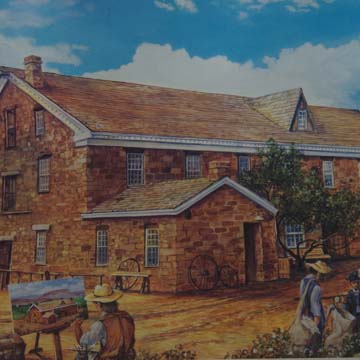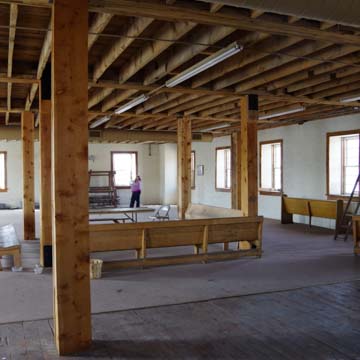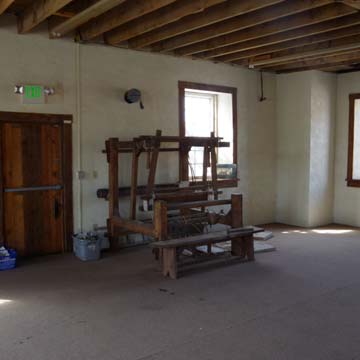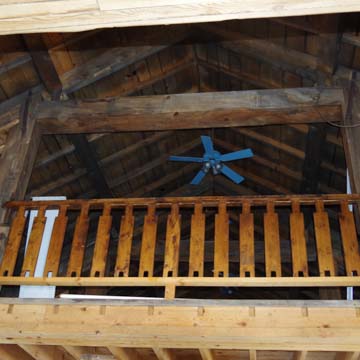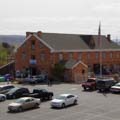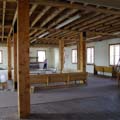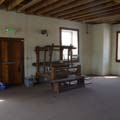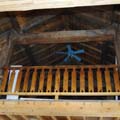You are here
Star Nursery Garden and Rock Center
The Washington Cotton Factory is the most conspicuous remnant of the Cotton Mission, which was aimed at discovering areas in the Utah Territory where Mormons could grow cotton for their own consumption. The effort was part of the Mormon response in southwestern Utah to the Mormon War (1857–1858). Mormon leader Brigham Young believed in economic self-sufficiency, and the war shored up Young’s resolve to create a Mormon-dominated industry and trade network. The U.S. cotton industry was dominated by slaveholding plantations in the American South, which sent cotton to northern mills, but in mid-nineteenth-century Utah, the industry was associated with the principle of Mormon self-sufficiency and colonization of native lands.
The factory is located in the sparsely populated part of Washington, Utah, at the base of an imposing 100-foot-high sandstone cliff. The site was chosen by James Richy and Benjamin F. Pendleton and sanctioned by Young, who put up $100,000 of his own money for the construction and acquisition of the factory equipment. Spinning mules and weaving stations were brought in from Missouri, ironically, which had expelled its Mormon settlers some thirty years prior. Under the flag of the Cotton Mission, Young sent forty families from neighboring territories to southern Utah to grow cotton. The erratic water flow from the Virgin River and its tributaries, combined with the alkali-rich soil of the desert, made growing the crop difficult. Dams were washed away in flash floods, and the cotton plants were not as fruitful as their eastern counterparts. Despite this, they persevered and Utah’s “Dixie” was born.
Construction of the factory began in 1865 under the direction of Appleton Harmon with stone masons Elijah and Elisha Averett and carpenter John P. Chidester. The one-story building was completed in 1867, but was soon enlarged with the addition of two stories. The rectangular building rises up from the flood plain of the Mill Creek to a height of over 40 feet at the apex of the pitched roof. The main volume measures approximately 85 feet in length and 45 feet in width. The 18-inch-thick main walls consist of rough-hewn sandstone laid in mortar. Inside, the floors, beams, and columns are all cut from cedar wood harvested from the nearby Cedar Mountain. The columns divide the space into 3 x 8–foot bays. Each side bay is punctured by a large sash window on each level. Most of the interior walls are plastered. Chimneys on either short end of the building kept the work area warm, and dormer windows in the center of the building illuminated the upper floors.
This was the largest cotton factory west of the Mississippi River. At its peak, 70-80 Mormon workers, mostly young women, spun thread and wove fabric, and the factory produced 500 yards of cloth per day. The factory used the water stored in a reservoir west of the mill. Fourteen hours of storage plus the stream flow could operate the factory for ten hours. A small branch of the Zion Commercial Mercantile Institution (ZCMI, one of America’s first department stores), operated in a small addition to the side of the factory. The “Factory” soon became a regional market for farmers to barter.
Settlers in the tough desert of Utah’s Dixie experienced epidemics, droughts, and floods. The cotton industry did not fare well. In 1890, the Mormon Church sold the factory to local businessman Thomas Judd, who expanded his business to include wool and even attempted to weave silk. Market pressures forced him to close in 1904. The machinery was removed in 1910 and the building was subsequently abandoned, although it briefly served as a CCC camp in 1935. It deteriorated over the years, and portions of the roof collapsed. In 1985, Norma Cannizzaro purchased the building and began restoring it to serve as an events center. After running out of funds, Hyrum and Gail Smith continued restoration in 1993, with plans to make it the centerpiece of a historic village. The project was never realized, however, and Star Nursery eventually purchased the building in 1998 to house its second location. The company restored the structure to its nineteenth-century condition and currently operates its store on the ground level; the second floor is open for public events and tours.
References
Writing Credits
If SAH Archipedia has been useful to you, please consider supporting it.
SAH Archipedia tells the story of the United States through its buildings, landscapes, and cities. This freely available resource empowers the public with authoritative knowledge that deepens their understanding and appreciation of the built environment. But the Society of Architectural Historians, which created SAH Archipedia with University of Virginia Press, needs your support to maintain the high-caliber research, writing, photography, cartography, editing, design, and programming that make SAH Archipedia a trusted online resource available to all who value the history of place, heritage tourism, and learning.














